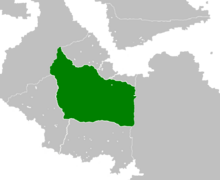Union of Basaqastan
This article is incomplete because it is pending further input from participants, or it is a work-in-progress by one author. Please comment on this article's talk page to share your input, comments and questions. Note: To contribute to this article, you may need to seek help from the author(s) of this page. |
Union of Basaquastan Yekitiya Basaquastane | |||||||||
|---|---|---|---|---|---|---|---|---|---|
| 1875–1955 | |||||||||
|
Flag of the Union of Basaquastan (1896 - 1955) | |||||||||
 The borders of the Union of Basaquastan | |||||||||
| Capital | Berqualin | ||||||||
| Common languages | Basaquese | ||||||||
| Government | Confederation | ||||||||
| Executive | |||||||||
• 1875 - 1952 | Council of State | ||||||||
• 1952 - 1955 | Council of Unity | ||||||||
| Legislature | Grand Council of Basaquastan | ||||||||
• Upper house | Chamber of Asagi | ||||||||
• Lower house | Chamber of Delegates | ||||||||
| History | |||||||||
• Amalgamation of the Union of Basaquastan | 14th August 1875 | ||||||||
• Union with Exberia | 3rd September 1902 | ||||||||
• Unification of Liberto-Ancapistan | 21st March 1955 | ||||||||
| Currency | Union Fiat | ||||||||
| |||||||||
The Union of Basaquastan (Basaquese: Yekitiya Basaquastane) was a confederation in central Basaquastan which existed between 1875 and 1955. The largest predecessor state of Liberto-Ancapistan by land area, it covered modern-day Basaquastan Hundir Province and large parts of modern-day Rojava-Navenda Province. It was composed of three constituent parts, Basaquastan Hundir, Sagharb, and Alanchi from 1875 to 1902, and four constituent parts with the addition of Exberia from 1902 to 1955.
The confederation originated in the 1869 Revolt of the Emirs, part of the Northern Revolt against the Santian Empire. Envisioned as a confederation of all the constituent states of Basaquastan, it failed to extend beyond its heartland in central Basaquastan, but continued to be the centre of Basaquastanian nationalism until the unification of Liberto-Ancapistan. A representative democracy with an elected lower house and appointed upper house, its constituent parts had governments ranging from the constitutional monarchies of Basaquastan Hundir and Alanchi to the direct democratic state of Sagharb. The union's executive consisted of a seven-person Council of State, selected by both the constituent parts and the Grand Council. The Union of Basaquastan had an agrarian economy in which pastoralism was common, with most industry in the country being limited to Exberia.
